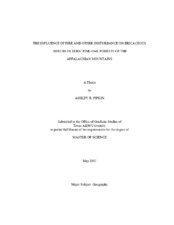| dc.description.abstract | Fire suppression in the southern and central Appalachian Mountains has resulted in an alteration to vegetation structure and composition. For this research the dominant species, abundance, density and age structure of the ericaceous shrub layer is characterized on four sites across the southern and central Appalachian Mountains. Fire histories for each of the sites varied, and were determined in previous research using dendroecological techniques. Over 800 ericaceous shrubs were collected, species included Pieris floribunda (Pursh) Bentham & Hooker f., Rhododendron maximum L. and Kalmia latifolia L.. Basal area of ericaceous shrubs was significantly different between sites. Age structures show that when fire suppression started Ericaceae began to establish. A few Ericaceae cross-sections displayed scars, that are likely associated with fire events, suggesting they probably survived mild fire events. Ericaceous shrub age structures were also compared to SPB outbreaks and PDSI. There were no significant correlations, but field observations suggest that SPB may be providing conditions suitable for Ericaceae establishment. Topographic patterns reveal that Kalmia latifolia is most abundant at mid-slope positions and decreases at higher and lower slope positions. There were significant differences in the density between slope positions averaged across all sites. Sites with the most recent and frequent fires did not have any of the three ericaceous shrubs collected at the slope bottom or ridge-top. At the most fire-suppressed site Ericaceae are present at every slope position. Age structures reveal that the oldest Ericaceae are found at the mid-slope positions while the age of thickets appears to decrease away from the mid-slope position. This pattern suggests that Ericaceae are moving into slope positions where they were previously less abundant. Sites with the most recent frequent fire regime seem to have prevented Ericaceae from heavily inhabiting high and low topographic positions while also reducing the overall basal area and density of Ericaceae. | en |


